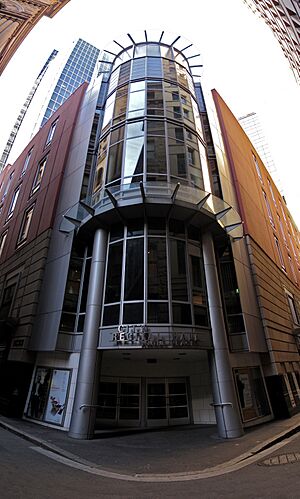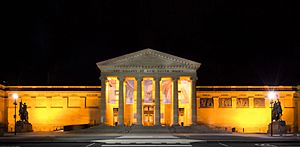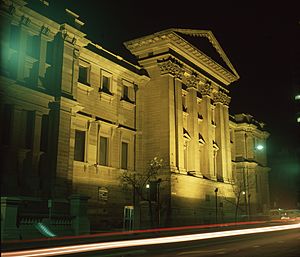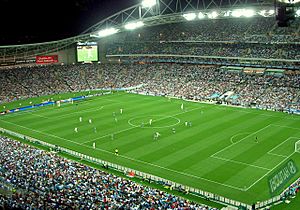Culture of Sydney facts for kids
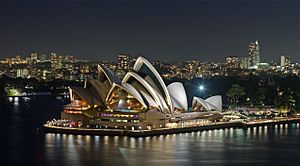
Sydney, Australia, is a city full of different cultures. Many of these cultures come from people who have moved to Sydney from all over the world. These groups have created communities based on their art, language, and traditions. Sydney is a big global city with lots of music, theatre, art, and other exciting activities.
Contents
Music in Sydney
The Sydney Symphony is a very famous orchestra. They often play at the Sydney Opera House. The City Recital Hall is another great place for music. It mainly hosts smaller orchestras and chamber music. You can hear groups like the Australian Chamber Orchestra there.
Opera Australia is one of the busiest opera companies in the world. They perform many classical and modern operas at the Sydney Opera House.
Sydney is also known for its rock music. Many famous Australian rock bands started here. Some well-known bands from Sydney include AC/DC, Midnight Oil, INXS, and 5 Seconds of Summer.
The city also has a lively alternative rock scene. Bands like The Vines and Wolfmother are from Sydney. The Big Day Out festival, which started in Sydney in 1992, brought together many local and international bands.

Popular Culture
Sydney has inspired many songs over the years. For example, "O! Sydney I Love You" was a popular song from 1927. "My City of Sydney" was another song often played on TV in the 1970s.
Performing Arts
The Sydney Festival happens every January. It is Australia's biggest performing arts festival. You can see classical and modern music, theatre, and visual arts during this time.
The Sydney Theatre Company performs Australian and international plays. Famous Australian actors sometimes return to the stage for these shows. Some main theatre places include The Wharf Theatre and the Belvoir St Theatre. The Bell Shakespeare Company performs plays by Shakespeare and other modern works.
Sydney has several large theatres for shows. These include the Capitol Theatre (built in 1928) and the State Theatre (built in 1929).
The Sydney Dance Company performs modern dance shows. The Australian Ballet also performs regularly in Sydney.
Visual Arts and Museums
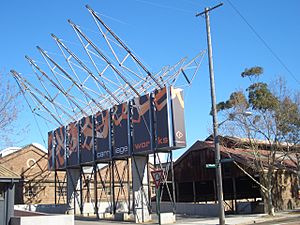
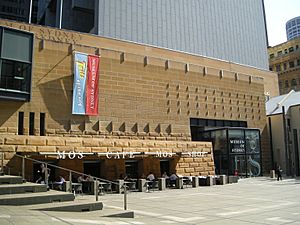

Sydney is home to many talented artists. The city has many museums and art galleries. These include the Museum of Contemporary Art and the Art Gallery of New South Wales.
The Art Gallery of New South Wales has a large collection of Australian art. It also has the biggest collection of Aboriginal art in the world. Important art prizes like the Archibald Prize are given out here each year.
The Museum of Contemporary Art (MCA) shows modern art from its own collection and from international artists. The Biennale of Sydney is a big festival for modern art. It takes place every two years at the MCA and other places.
You can also find lots of graffiti and street art in Sydney. Areas like Newtown and Surry Hills have many cool murals.
Film
Sydney is a major centre for film and media in Australia. Many famous movies and TV shows have been filmed or set here. For example, Finding Nemo was set in Sydney Harbour. Parts of The Matrix were also filmed in Sydney.
The international Sydney Film Festival happens every June. There are also short film festivals like Tropfest and Flickerfest.
Literature and Libraries
The Sydney Writers' Festival takes place every May. Writers from Australia and around the world come to share their stories and ideas.
The biggest library in Sydney is the State Library of New South Wales. It has over 4.7 million items, including many books. Most areas in Sydney also have their own local libraries.
Children's Entertainment
Many popular children's shows and music groups come from Sydney. These include the famous musical groups The Wiggles and Hi-5. TV shows like Play School and Bananas in Pyjamas also started here.
Sydney Communities
Sydney is a very multicultural city. People from many different countries live here. This means you can find many different cultures, foods, and languages across the city.
For example, some areas have a large Chinese community, like Hurstville. Leichhardt is known for its Italian community. Cabramatta has a large Vietnamese population.
Languages
Because so many people from different places live in Sydney, many languages are spoken. Besides English, some of the most common languages include:
Arabic and Cantonese each have over 150,000 speakers in Sydney!
Sport
Sport is a very important part of life in Sydney. New South Wales, where Sydney is located, has hosted many big international sports events. Sydney hosted the 2000 Summer Olympics. It also hosted the 1938 British Empire Games.
ANZ Stadium, which was the Olympic Stadium, is now used for many big games. It hosts the yearly NRL Grand Final for rugby league. It also holds international rugby and soccer matches. The final of the 2003 Rugby World Cup was played here.
The Sydney Cricket Ground hosts a big cricket match every year from January 2-6. The famous Sydney to Hobart Yacht Race starts in Sydney Harbour on Boxing Day.
Rugby
Rugby league is very popular in Sydney. The main offices for Australian Rugby League are in Sydney. Many of the top rugby league clubs are based here, including the Sydney Roosters and South Sydney Rabbitohs.
Sydney also has a local club rugby union competition called the Shute Shield. The NSW Waratahs are Sydney's team in the Super Rugby competition.
Australian Rules Football
Australian rules football, or AFL, is growing in popularity in Sydney. The AFL has two teams from Sydney: the Sydney Swans and the Greater Western Sydney Giants. The Swans moved to Sydney in 1982 and have won two championships since then (in 2005 and 2012). The Giants joined the league in 2012.
Soccer
Soccer also has a long history in Sydney. After World War II, many immigrants came to Sydney from Europe. They started their own soccer clubs to celebrate their communities. Some of the biggest clubs were Marconi Stallions Football Club (Italian), Sydney Olympic Football Club (Greek), and Sydney United Football Club (Croatian).
In 2005, a new club called Sydney FC was formed. They play in the A-League, which is Australia's top soccer league. Sydney FC has become very popular, with many fans attending their games.
Cricket
The NSW Blues are a very successful cricket team in Australia. They have won many championships. Their main home ground is the Sydney Cricket Ground. In the Twenty20 Big Bash League, Sydney has two teams: the Sydney Sixers and the Sydney Thunder.
Basketball and Netball
The Sydney Kings play in the National Basketball League (NBL). They have won several championships. The Sydney Uni Flames play in the Women's National Basketball League. In netball, the Giants Netball team was formed in 2017.
Images for kids
-
The cool Art Deco entrance to the State Theatre
-
The Capitol Theatre in Haymarket
-
The observation deck of the Sydney Tower offers amazing views of the city.


